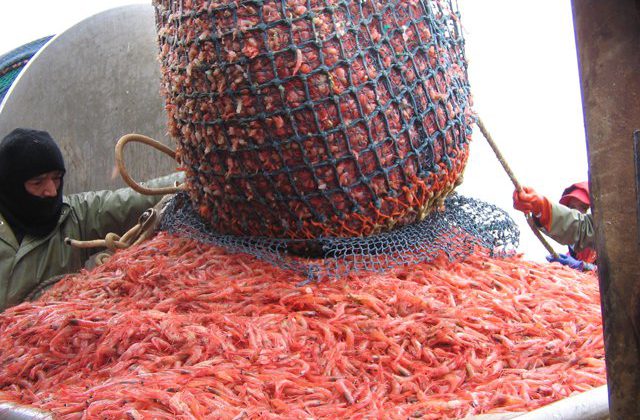Northern Shrimp in the Gulf of Maine
October 18, 2019
During the current period of climate change and the subsequent warming of the Gulf of Maine, many marine species in the area have been affected in different ways. One of these animals is the Northern shrimp, or the Pandalus borealis. This species has been in steady decline since 2006 and was finally placed under protection in 2013, a moratorium that has been extended through 2021 to allow the population to replenish. The 2019-2021 season was shut down in mid-November by the Atlantic States Marine Fisheries Commission (ASMFC), and no research quota has been allowed since the closure of the 2019-2021 seasons, because, “Any level of fishing pressure… would hinder any kind of stock rebuilding,” said Tina Berger, the director of communications for the ASMFC.
Although no fishermen have been relying specifically on Northern Shrimp as a source of income since the 2013 moratorium, it is still a setback for the economy and a blow to local fisheries. The species has been below the median in terms of population and biomass as of 2018, and unless particularly cold winters happen over the next few years, the shrimp population will not have the temperature range needed to lay eggs and rebuild the species to avoid total extinction in the Gulf of Maine. Research in 2016 indicated that the 2012-2015 seasons showed the lowest numbers in terms of population on record for the 32 years that scientists had been collecting that set of data. The rapidly warming waters in the Gulf of Maine that affect shrimp populations are due to climate change, a problem that affects all forms of a shrimp’s life cycle, including viability and fecundity, or the ability to reproduce. Colder temperatures are more favorable for shrimp, and years with colder water are solidly correlated with the years of plenty shrimp, while the currently warming waters cause shrimp to hatch around a month early, and causes high spikes in juvenile mortality rates for Northern shrimp in and around the Gulf of Maine. The high juvenile mortality rates mean that fewer and fewer fully grown adult shrimp are reproducing, meaning yet another area of population loss for the Northern shrimp.
While climate change has occurred in the past, there has not been such a visibly dire need of a solution as there is now. The Gulf of Maine is one of the fastest warming bodies of water globally, and is currently at its warmest temperature in 150 years of recorded history. This temperature is gravely affecting the survival of the Northern Shrimp.. Other marine species, such as lobster, flounder, cod, and pollock, are all being greatly affected by this change in one way or another. These species are mainly being forced northward or killed off, as their preferred temperature range being found closer and closer to the Arctic, reducing southern populations, and overcrowding habitats further north.
Research from the University of Maine at Machias shows that within around 700 species, including the shrimp, 90% of their respective populations will be gone by 2100, creating an even bigger problem that isn’t just focused on the Northern Shrimp. In 2013, only 255 metric tons of shrimp were caught, as opposed to 2012’s 2,185 metric ton haul, and 50 years ago, when it was roughly 11,000 metric tons. This is a major decline, showing an 88.33% decrease from 2012 to 2013, and around a 98% decrease from 50 years ago to 2013. Despite this data, many of the fishermen are claiming that the situation is not so dire and that the survey needs to be reworked. They claim that because the survey doesn’t reach to 90-100 fathoms, it cannot be accurate, as this range is where they have been reporting the most shrimp, and where the most fishing activity happens.
As of right now, Maine does not have a solution to this problem. If alternative fishing solutions are not found, nor other regulations created, the entire Northern shrimp population would be put into even more danger, especially if the moratorium is lifted after its 3-year sentence is over. The shrimp population is already in crisis due to the climate change in the Gulf of Maine, a problem which will take massive amounts of global action to even counter, much less solve. The effects of climate change on the Gulf of Maine and its species is astounding, and will continue to harm productivity and population until a solution is found and implemented. This means that the current shrimp fishing moratorium is necessary, despite the negative consequences for fishermen and their income.
Within the evaluation of the possibilities to rebuild the shrimp population, there are several uncertainties that need to be taken into consideration during discussions. Are the shrimp able to rebuild their population, or have they passed the tipping point? Will the reintroduction of the shrimp fisheries only cause the same cycle of harm and shutdown? There is currently no prediction for these variables, making an evaluation and best possible solution increasingly hard to decipher. It is also a more recent issue, giving only a few years of research to work with. The time frame makes an evaluation and viable solution much harder to appraise and come up with, and creates more strain on the scientific community’s relationship with the fishermen and the public. Furthermore, the viability of the shrimp populations would need to be monitored under the effects of fishing to be certain restrictions and other types of regulations that would ensure the continued viability of the shrimp populations in the Gulf of Maine.
Currently, the best course of action would be to assess the threat of climate change, and what steps can be taken in both the short term and the long term to prevent further habitat degradation and mitigate the current effects of climate change. As the Gulf of Maine is one of the fastest warming bodies of water in the world, the effects on Northern shrimp are even more dire than in other areas. Continued discussion about the effects of the warming waters and the scientific data shown through research is necessary for a conversation to continue about how to manage, and if possible rebuild, shrimp populations, and even the other populations that are dwindling due to the warming of the Gulf of Maine.


